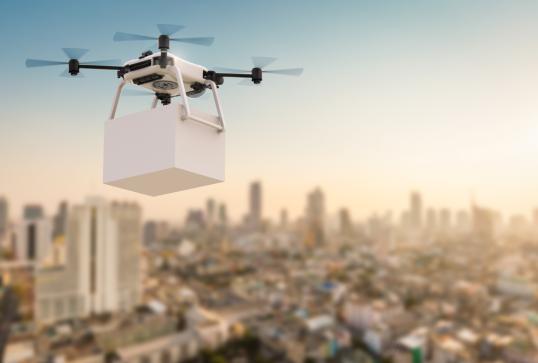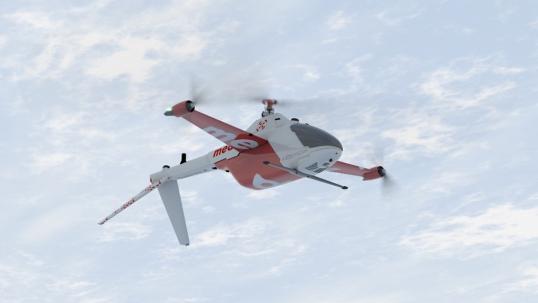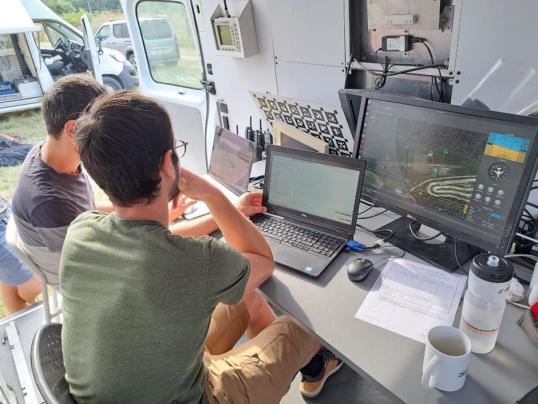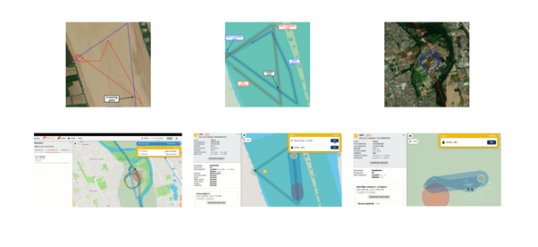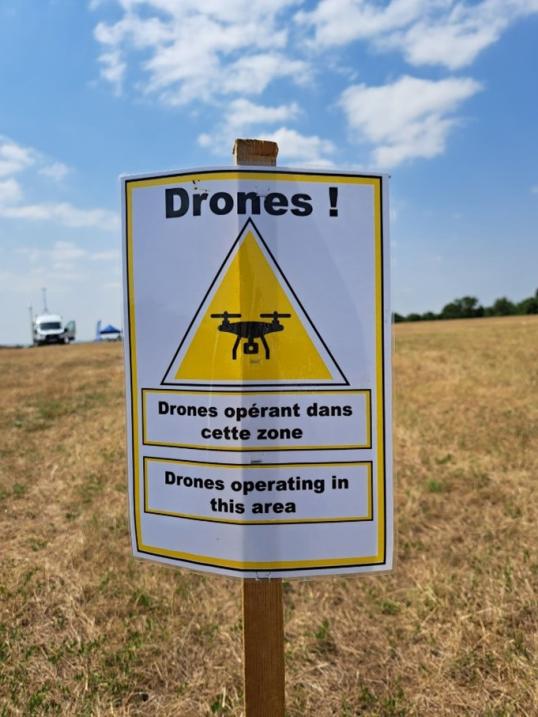- Topic
- Monitoring and evaluation
- Country
- Europe-wide
- Resource type
- Case study
First published on 16 February 2023.
In its Smart and Sustainable Mobility Strategy, which was adopted in December 2020, the European Commission underlined its support for the deployment of drones as part of the ongoing transition to sustainable, smart and resilient mobility sector. The use of drones in urban areas as part of advanced logistics systems was also highlighted in the Commission’s new Urban Mobility Framework, which was adopted in December 2021. On 29 November 2022, the European Commission has subsequently adopted its Drone Strategy 2.0 for a Smart and Sustainable Unmanned Aircraft Eco-System in Europe.
It is in this context that drones are increasingly being used in cities. Shifting a part of the city transportation flow from ground to air will help to reduce greenhouse gases, improve personal mobility and logistics, reduce travel times and city congestion on the roads, and provide new alternatives, especially for the most urgent distribution of freight/goods (such as medical supplies). The use of drones can also substantially improve many monitoring and data collection processes, such as traffic control or the gathering of pedestrian mobility data. The technology is now considered part of the Urban Air Mobility (UAM) trend. Whilst UAM covers both cargo/logistics and the transportation of passengers through manned electric vertical take-off and landing (eVTOL) aircrafts, this case study just focuses on the use of unmanned aircraft (drones).
There are many UAM projects (involving accelerating entrepreneurship, piloting, and performing demonstrations) that are making advances in European cities. They share an open attitude towards an unexplored future and are typically run by entrepreneurs, new technological firms, national bodies or universities, that come together to share their experiences and collaborate. They seek to establish liaisons with regulatory and governmental organisations to facilitate the scale up of their projects and create a more expansive UAM ecosystem.This case study focuses on ongoing projects in Hamburg, Toulouse and Bordeaux, which combine innovation, underline the need for the standardisation of the activity, and reveal an unveiled ambition for research into the public perception of the new trends.
- Medifly-Hamburg is a UAM service for the rapid transport of medical goods, such as medicines, laboratory and tissue samples, between the health institutions of the city of Hamburg, Germany.
- TINDAiR involves a series of large-scale UAM demonstrations across France, including in Toulouse and Bordeaux, and focuses on tactical deconfliction (1) to ensure the unlimited, unrestricted and safe cohabitation of all airspace users.
Social acceptance of UAM is also an important area that is being explored further. Research on public opinion is starting to look at the way citizens view and interpret these new concepts. The European Union Aviation Safety Agency (EASA) organised a study on the societal acceptance of UAM operations, and this gave a comprehensive insight into public perceptions of this new, radical form of mobility.
Context
Whilst UAM is in its early stages, it has the potential to overcome many ongoing urban mobility challenges within cities. For example, in terms of logistics, the final point of merchandise unloading within a city generates different issues that have not yet been resolved, such as congestion, a concentration of freight vehicles on logistic nodes that may coincide with dense areas of the city, and the increasing fuel costs for the operators.
One city seeking to address the ongoing challenges is Hamburg, Germany where the government has committed to exploring UAM opportunities and developing this sector. Like many cities across the world, Hamburg is living with the problems brought about by growing urbanisation based on car-oriented planning, such as:
- increased intensity of commuting and commercial traffic,
- a rise in the overall demand for mobility,
- a shortage of space to allocate to transport flows, and
- an ageing population bringing with it pressure on the healthcare system.
At the same time, Hamburg is the world’s third largest civil aviation location (2) and home to a great deal of expertise. As a metropolis with an inner-city airport and a broad network of hospitals, Hamburg is both a challenging and significant “testing ground” for the future use of unmanned air technologies in urban spaces.
Since 2018, Hamburg has been a member of the UAM initiative of the “European Innovation Partnership on Smart Cities and Communities”. The initiative is supported by the European Commission and brings together cities, industry, SMEs, banks, research organisations and other smart city stakeholders whose main goal is to improve citizens’ quality of life in urban contexts. Hamburg has been highlighted as an illustrative case of UAM adoption. Its distinctive feature is the close cooperation between industry, research institutions and the government, who together, implement use cases and technologies associated with UAM in the metropolitan region, to enable its progressive expansion in the coming years.
In 2018, the City of Hamburg and local industry also signed a letter of intent to become an EU model region for UAM. The city authorities act as enablers and generate incentives to encourage the participation of the private sector. Building on the letter of intent, several Hamburg-based companies have joined forces to launch the project “Medifly Hamburg”. The research goal of the project is to find out how far unmanned aircraft systems can be used to perform the time-critical transport of medical samples in a safe and reliable manner.
Another two cities that have worked within the UAM entrepreneurial ecosystem are Toulouse and Bordeaux, where the project TINDAiR – Tactical Instrumental Deconfliction and In-Flight Resolution – was born. Both cities have focused their efforts on staging and hosting trials and demonstrations to integrate unmanned aircraft into the existing airspace, paying attention to the legal, operational and coordination challenges that this brings about. This is aligned with the strategy of both cities to build spaces for innovation and scientific advancement. The cities have programmes aiming to help selected UAM start-ups grow their businesses around Europe. This is not only a boost to the local economy but an endorsement of sustainable projects. It is perceived that air transport has the potential to expand urban ground transport to support a reduction of congestion in cities.
In action
Hamburg
Medical interventions often require extracting tissue samples and taking them to external labs for diagnosis. This logistical operation can last several hours and extend the medical procedure under analysis. Therefore, a big challenge for such situations is to move these urgent medical samples to the lab in a timely manner. However, congestion makes this activity increasingly difficult, ultimately causing delays to medical tests and results. Drones have the potential to make an important contribution – avoiding congestion altogether and simplifying the movement of goods in a shorter time.
To test the potential of this means of transport, the Medifly-Hamburg project used a 10kg special Globe drone that started at the Bundeswehr hospital in Wandsbek and ended at Marien hospital in Hohenfelde, which is located in an urban area within the control zone of Hamburg Airport. The drone flew a distance of five km between the two hospitals (as the crow flies) with artificial medical samples, at a height of 75 metres above the ground, reaching the target within 10 minutes. A speed of 40 km/h was achieved during the test, although the drone can achieve 80 km/h in real world operations without any problem.
France
TINDAiR set itself the challenge of integrating the new air mobility technology safely alongside existing crewed aircraft and air traffic. To tackle this, the research and innovation programme SESAR Joint Undertaking(link is external) has been pooling Europe’s resources and expertise to develop new operational concepts around the safe and secure integration of drones into airspace operations.
The integration tests were run between December 2021 and January 2022 in Toulouse by various TINDAiR Consortium members (Pildo labs, Collins Aerospace, Skybirdview, ONERA and InnovATM, among others). The main objective of these integration tests was to ensure that the interaction between platforms and the ground station was effective in real-life conditions. The idea was to test the innovative aspects of the project in real-life scenarios, before the official demonstrations took place. The first days of testing were devoted to indoor trials, and by the third day, the team was ready to go into the field to test the communication link outdoors.
Results
Hamburg
The Medifly test drone proved to be faster at travelling between the two hospitals, with ambulances connecting the same hospitals taking an average of 15 minutes by road (compared to 10 minutes by air).
In addition to the benefit of speed over road transport, drones also have environmental benefits as they are powered by electricity. In fact, the main fixed wing drone used by Medifly (GT20 Gyrotrak by Airial Robotics) for flights is also more efficient, with a much longer range (up to 150 km) compared to a multicopter with comparable cargo capacity. The energy required to make the device is in the order of that consumed by a small refrigerator and the data processing equipment committed to the activity has the energy consumption of a standard laptop.
France
Although still in the trial stage, pilots, demonstrations and advancements for integrating UAM technology are progressing rapidly. The TINDAiR consortium operated a series of demonstrations in Toulouse and Bordeaux covering a range of representative and operational use cases, featuring a combination of crewed and uncrewed aircraft.
Operational scenarios addressed existing urban needs ranging from medical emergency transport to a mix of freight and passenger flights. In this context, tests of extreme use cases were also exercised, such as a scenario of potential saturation in the capacity of UAM, a scenario for an emergency landing for when a drone does not respond properly or shows signs of failure and demonstrated conflict detection and resolution by sending solutions considering flight priorities. They also tested different types of platforms with various capacities and levels of automation, all sharing the same airspace volume.
The TindAIR integration testing successfully demonstrated the efficient link between the drone payload and the ground station, which was at all moments maintained and able to transfer important data to the deconfliction software and vice-versa. For the radio link between vehicles and the supervisor, the 9 km range was achieved with almost no error, data was sent every second as planned, and more than 99% of the data was received and processed within 2 seconds.
- Demonstration results illustrated the TINDAiR system can: detect and resolve conflicts at strategic and tactical levels
- manage emergences by the detection of hazardous situations and commanding suitable emergency landing orders
- ensure indispensable services such as tracking, network identification, traffic information, geo-awareness or monitoring
Flight results highlighted that the system is compliant with the U-Space Concept of Operations (ConOps) flow (at least within the limitations of the flight demonstration scenarios). Strategic and tactical de-confliction services were tested in a relevant environment, and their coordination with other U-space services (tracking, emergency Management, geo-awareness, etc.) was also demonstrated.
The flights in France provided an opportunity to demonstrate a tactical conflict resolution service module that embeds an artificial intelligence algorithm, which could be integrated into future deployments.
Social acceptance of UAM
EASA conducted a study in May 2021 to examine the attitudes, expectations and concerns of EU citizens with respect to UAM. Through literature reviews, local market analysis, surveys and interviews, the study revealed interesting insights that will help EASA prepare the future regulatory framework:
- EU citizens showed a positive attitude and interest towards UAM (83% of 3,690 respondents across six European cities (3) and it is seen as a new and attractive mode of mobility which the majority would consider trying.
- Providing benefits to the general population is a key driver of acceptance. Interventions that impact positively on a given community, such as medical or emergency transport, or those connecting remote areas, have greater support than interventions that satisfy individual/private requests. In fact, 41% of 3,690 respondents supported drone transport of injured persons or medical supplies to hospitals as the most useful cases.
Human factors and social acceptance were also assessed through surveys and interviews as part of the TINDAiR project. Various conditions were identified for the social acceptance of UAM – not only should it bring benefits to all citizens, but most importantly it should also be used for emergency and disaster management and medical transports (in support with EASA’s findings), as well and for monitoring public transport. It should use renewable energy, and clearly define certifications and rules in case of incidents.
The results also highlighted concerns about the noise of such traffic, whilst other opinions touched upon safety and possible accidents, public distrust of technology, a possible negative impact on the environment, the creation of social inequalities and the potential negative impact on privacy.
Other European projects
On 29 June 2022, the five SESAR 3 JU Digital Sky Demonstrators that will receive funding of EUR 47.5 million from the Connecting Europe Facility by 2025 were announced. Three of these projects aim to accelerate the market uptake of UAM. The U-ELCOME (U-space European COMmon dEpLoyment) Project will include a set of demonstrations in various operational environments and locations across Europe (Spain, Italy and France). BURDI aims to demonstrate the feasibility of managing dense and complex unmanned aircraft systems operations in controlled, uncontrolled and UAM environments. Finally, EALU-AER aims to demonstrate U-space architecture operations (U1 and U2 services) and its integration with air traffic management, to identify world-class drone traffic management technology solutions. The Digital Sky Demonstrators will take place in live operational environments and will test, on a very large scale, the technological solutions required to deliver the Digital European Sky.
A growing number of collaborative research and innovation projects under the EU Research and Innovation programme Horizon 2020 are addressing drones and UAM. In the cluster of projects managed by the European Climate, Infrastructure and Environment Executive Agency’s (CINEA), projects are developing new know-how and are testing innovative solutions that help to make transport safer, more efficient and more resilient. For example, AiRMOUR (2021-2023) is another project that focuses on medical services transported by air in urban areas, the public acceptance of these and their safety aspects, as well as the role of cities and tools to help with this new form of mobility. AURORA (2020-2023), on the other hand, focuses on emergency-related UAM applications such as urgent logistics, chemical incident response, and fire-fighting support.
Also managed by CINEA, ASSURED-UAM is a H2020 Coordination and Support Action (2021-2023) contributing to CIVITAS initiative to prepare for the deployment of UAM in urban and peri-urban areas. In particular, the project will provide a set of acceptance, safety and sustainability recommendations for efficient deployment of UAM. To make sure that the modelling conditions of new mobility services, such as drones and UAM, are accurately integrated in transport modelling tools, the HARMONY project (2019-2023) carried out real life demonstrations of drones to deliver medicines and also for the last mile delivery of parcels (electric vans equipped with drones). The results of these tests have been integrated in the HARMONY Model Suite (the integrated spatial and transport planning tool).
Challenges, opportunities and transferability
Whilst advancements are being made in this field, the main concerns that still exist are security (cyber) and safety. Therefore, to be part of the UAM transport revolution, drones first need to demonstrate that they are safe and secure to fly. This starts with dedicated operations on specific routes where prototype vehicles, which will be piloted initially, can be tested and monitored. Concepts such as Remote ID, where each drone can provide information on identification and location, also need to be in place. This will then have an impact on the level of awareness and perception of the public.
The novelty of the industry poses a challenge to the advancement of this technology. To ensure a sustainable and responsible approach to the development of UAM services, it is important that cities and regions are informed and actively involved to ensure the integrated and sustainable planning for mobility, and wider urban development, for the benefits of their citizens. The UIC2 (UAM Initiative Cities Community) therefore has an important role in shaping the future of airborne mobility above our cities and regions. Created in 2017 with more than 40 cities, it is a city-centric (and regions) and citizens’ needs-driven community that brings the voice of European cities and regions in the emerging sector of urban air mobility, with the aim to drive the sustainable and responsible transition of urban mobility to the vertical (third) dimension. Since September 2022, UIC2 is part of the CIVITAS community. The UIC2 has also developed extensive guidance through a practitioner briefing on how cities and regions can implement UAM in mobility planning and urban development in the context of Sustainable Urban Mobility Planning (SUMP), to support cities on their path to implementing UAM.
On 29 November 2022, the European Commission adopted a Drone Strategy 2.0 for a Smart and Sustainable Unmanned Aircraft Eco-System in Europe. Developing IAM (UAM extended to regional and even international flights) is one of the line of actions of the strategy, with the Commission intending to adopt rules for the ‘certified’ category of drone operations, addressing the initial and continued airworthiness of drones subject to certification; and the operational requirements applicable to manned VTOL-capable aircraft. The Commission will also adopt rules for the design and operations of vertiports as well as develop balanced economic and financial requirements for licensing of IAM operators.
EASA already published the Special Condition for manned VTOL aircraft certification and related Means of Compliance, as well as Prototype Technical Design Specifications for Vertiports. Work is ongoing on the introduction of a regulatory framework enabling urban air mobility with manned VTOL-capable aircraft, with EASA having published a first Notice of Proposed Amendment in 2022.
A wide range of stakeholders from traditional aviation systems, start-ups, research institutes, universities, drone operators, service providers, airports, local/city authorities, law enforcement agencies and civil aviation authorities need to be brought together to establish common agreements and an understanding from which to build the commercial and operational UAM environment. Collaboration and public co-creation at the local level also needs to be included. The establishment of a mechanism of coordination between the competent authorities and other entities including at local level for the designation of U-pace airspace is provided in the Regulation on a regulatory framework for U-space which is applicable since the 26 January 2023. The implementation and further development of the new regulatory framework requires the coordination of these stakeholders and the knowledge produced through the tests and demonstrations managed by EASA. Ground and air synergies are also required, and public and private support through funding and finance need to be established.
To achieve this, the Commission, on the basis of a European Parliament initiative, will fund the development by EASA of an online platform as a “pilot project Sustainable IAM Hub” that would provide support to the authorities, cities, industry and other stakeholders for Innovative Air Mobility implementation. This European cross-sectorial governance platform for Innovative Air Mobility should enable engagement, alignment, and coordination between the different stakeholders. This platform should also contribute to increasing public knowledge on the environmental impact of drones.
(1) Deconfliction is an engineering term that refers to the process of avoiding mutual interference, or outright hazards, between systems.
(2) https://medifly.hamburg/en/project/
(3) Paris, Rome, Barcelona, Hamburg, Budapest and the Oresund Region (covering Copenhagen, Denmark and Malom, Sweden)
In Depth
Resources for additional reading:
- A Drone strategy 2.0 for Europe to foster sustainable and smart mobility https://ec.europa.eu/info/law/better-regulation/have-your-say/initiatives/13046-A-Drone-strategy-20-for-Europe-to-foster-sustainable-and-smart-mobility_en
- Special Condition for VTOL and Means of Compliance https://www.easa.europa.eu/en/document-library/product-certification-consultations/special-condition-vtol#group-easa-downloads
- Prototype Technical Design Specifications for Vertiports https://www.easa.europa.eu/en/document-library/general-publications/prototype-technical-design-specifications-vertiports
- NPA 2022-06 - Introduction of a regulatory framework for the operation of drones — Enabling innovative air mobility with manned VTOL-capable aircraft, the IAW of UAS subject to certification, and the CAW of those UAS operated in the 'specific' category https://www.easa.europa.eu/en/document-library/notices-of-proposed-amendment/npa-2022-06
- Demonstrating the everyday benefits of U-Space. Initial results from SESAR demonstrations (2020-2022). SESAR Innovation Pipeline 2021: Air traffic management research and innovation (sesarju.eu)
- Launching a Pan-European Urban Air Mobility Projects & Initiatives Community to Foster Sustainable Development of the UAM ecosystem. Launching a Pan-European Urban Air Mobility Projects & Initiatives Community to Foster Sustainable Development of the UAM ecosystem – TindAIR
- Medifly project description. Project description – Medifly Hamburg
- Study on the societal acceptance of Urban Air Mobility in Europe, May 2021. uam-full-report.pdf (europa.eu)
- Jahresbericht: Der Hambuguer Cluster. Jahresbericht_Hamburger_Cluster_2020_final.pdf (uni-hamburg.de)(link is external)
- Urban Air Mobility and Sustainable Urban Mobility Planning – Practitioner Briefing - https://www.eltis.org/sites/default/files/practitioner_briefing_urban_air_mobility_and_sump.pdf
- Acceptance, Safety and Sustainability Recommendations for Efficient Deployment of UAM. CORDIS website of H2020 EU-funded project ASSURED-UAM.
- Drones and Sustainable Urban Air Mobility (UAM) brochure on H2020 projects managed by CINEA(link is external).
- Research and Innovation in Urban Mobility and Logistics in Europe, 2022-09-08 https://publications.jrc.ec.europa.eu/repository/handle/JRC130426
- ASD Urban Air Mobility and Sustainable Development: How to assess the UAM as a contributor to sustainable development: A framework towards transitioning to sustainability-driven business model(s). 8/2/2023, UAM White Paper January 2023.pdf (paddlecms.net)
Author: Andres Kilstein
Views and opinions expressed are those of the author(s) and do not reflect those of the European Commission.
Photo Credits: Medifly project, TindAIR project, © Phonlamai Photo - no permission to re-use image(s) without separate licence from Shutterstock.

